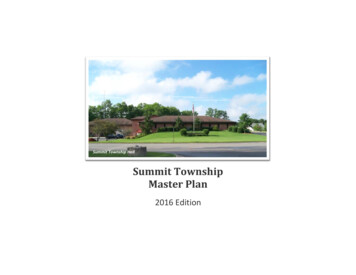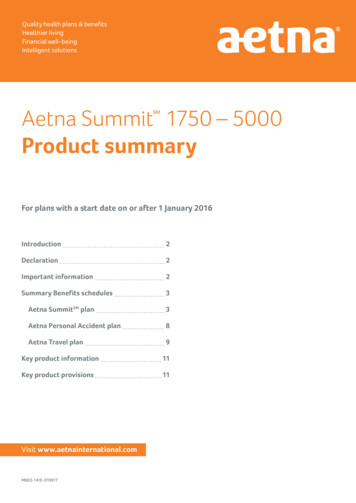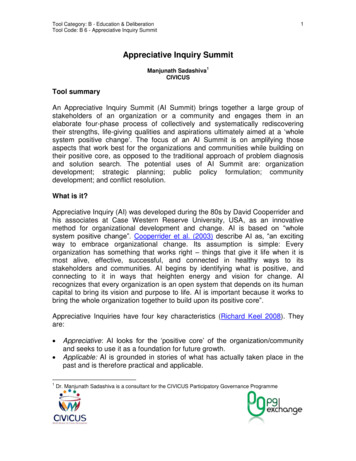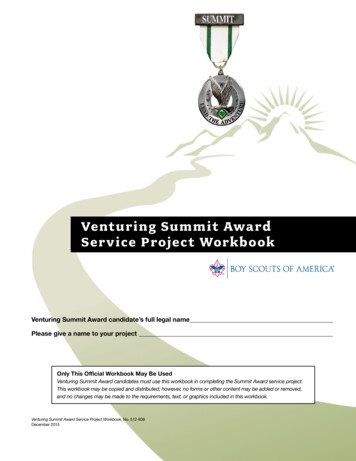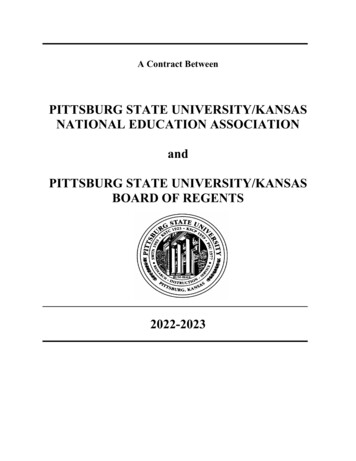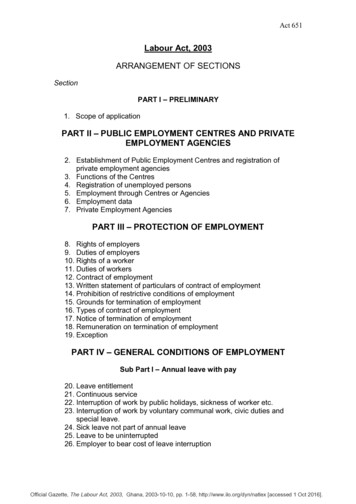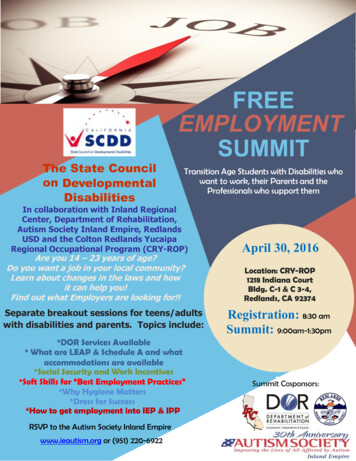
Transcription
The State Councilon ition Age Students with Disabilities whowant to work, their Parents and theProfessionals who support themIn collaboration with Inland RegionalCenter, Department of Rehabilitation,Autism Society Inland Empire, RedlandsUSD and the Colton Redlands YucaipaRegional Occupational Program (CRY-ROP)Are you 14 – 23 years of age?Do you want a job in your local community?Learn about changes in the laws and howit can help you!Find out what Employers are looking for!!Separate breakout sessions for teens/adultswith disabilities and parents. Topics include:*DOR Services Available* What are LEAP & Schedule A and whataccommodations are available*Social Security and Work Incentives*Soft Skills for “Best Employment Practices”*Why Hygiene Matters*Dress for Success*How to get employment into IEP & IPPRSVP to the Autism Society Inland Empirewww.ieautism.org or (951) 220-6922April 30, 2016Location: CRY-ROP1218 Indiana CourtBldg. C-1 & C 3-4,Redlands, CA 92374Registration: 8:30 amSummit: 9:00am-1:30pmSummit Cosponsors:
Employment Summit 2016Agenda*Group “A” Self-Advocates/Job Seekers*Group “B” Family Advocates & ProfessionalsTime8:30 - 9:00GroupGroups A & BRoomMain ConferenceRoom C-2/3Main ConferenceRoom C-2/39:00 - 9:05Groups A & B9:05- 9:30TopicCheck-in RegistrationWelcome GreetingsTamica Foots-Rachal , SCDD Regional managerGroups A & BMain ConferenceRoom C-2/3“Department of Rehabilitation Service Delivery Model”Alfonso Jiminez, DOR CaPromise Team Manager9:30 – 10:00Groups A & BMain ConferenceRoom C-2/3“LEAP Exam & Schedule A”Toussaint Wade, DOR Employment Coordinator10:05- 10:50Group BMain ConferenceRoom C-2/3“Getting Employment into Documents; IEP & IPP”Vanessa Fairbanks, Redlands Resource Specialist andRobert Garcia IRC Transition Manager10:05- 10:50Group AConferenceRoom C-1“Soft Skills” What are they &Why are they ImportantBy Arman Khodaei, Self-Advocate10:55-11:40Groups A & BMain ConferenceRoom C-2/3“Overview of Social Security Benefits & Wages”Paul Ceballos, DOR District Operations Support Manager11:45- 12:30Group BMain ConferenceRoom C-2/3“Autism Behind the Camera”Autism Society Inland Empire11:45- 12:30Group AConferenceRoom C-1“Dress for Success”Shannon Meehan, SCDD Community Program Specialist12:35- 1:15Group A & BMain ConferenceRoom C-2/3“Ordinary to Extraordinary”by Jonathan Mills, Employer1:15-1:30Group A & BMain ConferenceRoom C-2/3Closing Comment & Raffle Drawing*Note: After each group session you will be asked to fill out a Feedback Survey. For each survey you complete youwill receive a RAFFLE Ticket. We will draw raffle tickets at the end of the Summit for various prizes.YOU MUST BE PRESENT TO WIN.**All presentation materials will be posted on line at http://www.scdd.ca.gov/sanbernardino.htmSpecial Thanks to Our Presenters
Presented by:Alfonso Jimenez, SSM1
Vision Statement/ MissionStatementVision:Employment, independence and equality for allCalifornians with disabilities.Mission:The California Department of Rehabilitation(DOR) works in partnership with consumers andother stakeholders to provide services andadvocacy resulting in employment, independentliving, and equality for individuals withdisabilities.
Core ValuesThe values under which we operate all of our programs and services. QualityStrive to meet stakeholders' needs through continuous improvement,competence, creativity, and teamwork. RespectBe sensitive to the diverse needs of others, both internal and externalstakeholders, by being courteous, compassionate, responsive, and professional. IntegrityIn all endeavors, act in an ethical, honest, and professional manner. OpennessBe willing to listen to and share information with others. Be flexible, inclusive,trusting, and receptive to new ideas. AccountabilityTake ownership and responsibility for actions and their results.
Who Should Apply? Do you have a disability? Do you want to work? Are you having trouble getting or keeping a job becauseof your disability? Do you believe VR services, such as job placement,training, or other job preparation, would help you get orkeep a job? If you answered "yes" to any or all of these questions,you may qualify for DOR services.
Referral to Other AgenciesThe DOR also provides information and referral services topersons who do not wish to apply for services but requestor need referral to another agency or program such as:– Schedule A: This form of federal assistance is available topersons with disabilities applying for federal jobs. Schedule Arequires a certification letter from a DOR VR counselor.– Limited Examination and Appointment Program (LEAP): TheLEAP helps recruit and hire persons with disabilities into Stateservice in specific State job classifications. Persons who qualifyfor the LEAP can apply for any LEAP-specified examination ifminimum qualifications are met. The LEAP eligibility andparticipation require disability certification from a DOR VRcounselor.
How Do I Apply for Services?There are three requirements that comprise the application process.1) Request VR services in one of the following ways:a. Contact the local DOR office in your area. Complete and sign form DR222—Vocational Rehabilitation Services Application.b. Apply for Services online at the DOR website: www.dor.ca.gov or print anapplication from the DOR website and mail the completed form DR 222—Vocational Rehabilitation Services Application to your local DOR office.c. Visit an America's Job Center of California (formerly One-Stop CareerCenters) Complete an intake application form requesting VR services.2) Provide the DOR with information necessary to begin an assessment todetermine eligibility and priority for services.3) Be available to complete the assessment process. This includes activitiessuch as attending the initial interview, watching an orientation video,participating in the evaluation of your skills and capabilities, and completingyour part of any actions you and your VR counselor agree upon.
Assessment Process The purpose of the assessment process is to allow you and your VRcounselor to discuss: Your disability and how it affects your ability to work. The types of DOR services you may need to become employed. Eligibility—You and your VR counselor will: Obtain and review medical and other information to determine howyour disability affects your ability to work. Determine how DOR services can help you get or keep a job. After obtaining enough information, your VR counselor willdetermine your eligibility for DOR services.
EligibilityIf the DOR receives complete information about your disability, your VRcounselor will notify you in writing of your eligibility within 60 days of meeting thethree requirements of application. If information about your disability is incompleteor delayed, you and your VR counselor will agree on a specific extension date todetermine your eligibility.To be eligible for services, an individual must:– Have a physical or mental impairment that substantially impedes his orher ability to secure employment and VR services are required to preparefor, secure, retain, or regain employment consistent with the applicant'sunique strengths, resources, priorities, concerns, abilities, capabilities,interests, and informed choice.– Be able to benefit from the DOR services in terms of an employmentoutcome in an integrated setting.– If you are receiving Social Security Administration benefits or if youhave a valid "Ticket to Work," you are presumed eligible for DORservices.
Receiving ServicesThere are three priority categories: Individuals with the most significant disabilities (priority category 1). Individuals with significant disabilities (priority category 2). All other eligible individuals determined to have a disability (priority category3). Within each disability priority category, consumers will be served according totheir date of application.Waiting List: If the DOR does not have enough funding to serve eligibleindividuals in your disability priority category, you will be placed on a waiting list.The DOR will also: Notify you as to which category is being served. Notify you as soon as funds are available, and when you will be served basedon your application date. You may contact the DOR at any time regarding your desire to remain or beremoved from the waiting list. While you are on the waiting list, the DOR will provide you with informationand referrals to other services that may help you reach your employment goaluntil you receive the DOR services.
Individualized Plan for Employment(IPE) You and your VR counselor will jointly develop your I P E, if you:– Have applied for services.– Completed the assessment process.– Are found eligible for services.– Are placed in a disability priority category being served.The I P E is your written plan listing your job objective and the DOR services you willreceive to reach your employment goal. You and your VR counselor will discuss yourunique strengths, resources, priorities, concerns, abilities, capabilities, interests, andinformed choice as you develop your I P E.You and your VR counselor will work in partnership in developing your I P E.You and your VR counselor will determine your employment goals.You will have the opportunity, within the DOR's regulations, to discuss and choosethe specific VR services, providers, and settings you need to reach your employmentgoals.You and your VR counselor will discuss the process to obtain needed services.
Employment Services The DOR will provide the range and duration of services necessary to assist you tosecure, retain, or regain employment. Not all available services are needed by all consumers. The DOR's services include,but are not limited to:– Counseling and guidance.– Referrals and assistance to get services from other agencies.– Job search and placement assistance.– Vocational and other training services.– Evaluation of physical and mental impairments.– On-the-job or personal assistance services.– Interpreter services.– Rehabilitation and orientation/mobility services for individuals who are deaf/hardof hearing and/or blind/low vision.– Rehabilitation assistive technology services and devices.– Supported employment services.– Transportation as required, such as travel and related expenses, that isnecessary to enable you to participate in a VR service.– Transition services for students.– Post-employment services.
DOR Partnership Programs Transition Partnership Program- TPPCounty Mental Health ProgramCommunity College Workability IIICal State University Workability IVInland Regional CenterLocal Education Agencies- LEA/CAPromise
DOR’S GOAL The California Department of Rehabilitation (DOR)administers the largest vocational rehabilitation programin the country. We have a three-pronged mission to provide servicesand advocacy that assist people with disabilities to liveindependently, become employed and have equality inthe communities in which they live and work. DOR provides consultation, counseling and vocationalrehabilitation, and works with community partners toassist the consumers we serve. To obtain gainfulintegrated employment.
DOR District Offices Statewide Where to Find Information: DOR website: www.dor.ca.govSouthern Region– Greater Los Angeles District (213) 736-3904– Los Angeles South Bay District (562) 422-8325– Orange/San Gabriel District (714) 991-0800– Inland Empire District (951) 782-6650– San Diego District (619) 767-2100– Van Nuys/Foothill District (818) 901-5024Northern Region– Greater East Bay District (925) 602-3953– San Joaquin Valley District (559) 445-6011– Northern Sierra District (916) 558-5300– Redwood Empire District (707) 576-2233– San Francisco District (415) 904-7100– San Jose District (408) 277-1355– Santa Barbara District (805) 8130
Inland Empire District OfficeRiverside District Office is located at– 2010 Iowa Avenue, Bldg. E, Suite 100– Riverside, CA, 92507– Phone number (951) 782-6650
Thank you,
Department of RehabilitationLEAP Schedule A Workshop1
Purpose To clarify the processes through which Vendors, CommunityPartners, Consumers, and DOR interact to improve servicesto persons with disabilities. To gain greater familiarity with the LEAP and OJT processes. Increase knowledge regarding the criteria for qualificationsof LEAP and OJT services.2
LEAPBackground The Limited Examination and Appointment Program (LEAP),established by the State Personnel Board in 1989, is an alternateexamination and appointment process for the recruitment and hiringof individuals with disabilities into State service. The utilization of LEAP in the hiring and appointment process is anintegral part of the California Model Employer Initiative (CMEI).Therefore, Department of Rehabilitation (DOR) field offices shouldanticipate more interest in the LEAP process and requests for LEAPcertification as a result of the CMEI marketing campaign.3
LEAP ComparisonCompetitive ExamsLEAP Exams Scores determine eligibility listrank Only top ranks (usually 1-3) getcalled for interview Ranks fluctuate depending onnumber of applicants andscores received Pass/Fail Passing scores immediatelyeligible for interviews andemployment through a jobexamination period No list fluctuation4
LEAP Eligibility CriteriaIn order to qualify for LEAP certification, an individual mustmeet the following California Fair Employment and Housing(FEHA) criteria: Has a physical or mental impairment or medical conditionthat limits one or more major life activities; Has a record or history of such impairment or medicalcondition; or Is regarded as having such an impairment or medicalcondition.5
LEAP Eligibility CriteriaA LEAP applicant who is not a DOR consumer must provide verification of thedisability, sufficient to determine that the LEAP eligibility criteria have been met.The verification can include any of the following: Medical records;Educational records;An obvious impairment (e.g., loss of a limb);A recent copy of a Social Security Administration (SSA) award or continuationletter that the individual is receiving Supplemental Security Income/SocialSecurity Disability Insurance (SSI/SSDI) benefits due to his own disability; A recent copy of a Benefits Planning Query Report (BPQY) from SSA. DOR consumers meet the LEAP eligibility criteria.6
LEAP Certification ProcessNon-consumers of DOR Schedule a LEAP eligibility determination meeting with aDOR counselor Once the individual has provided sufficient documentationto verify LEAP eligibility, and the individual's identity hasbeen verified through a driver's license or photoidentification, the rehabilitation counselor and individualsign the DR 10 (LEAP Certification) in blue ink, a signedcopy is provided to the individual and the original is mailedto Sacramento.7
LEAP Certification ProcessDOR Consumers For current DOR consumers, the rehabilitationcounselor should complete the LEAP certificationwithin 24 hours of the initial interest The rehabilitation counselor and consumer sign theDR 10 (LEAP Certification) in blue ink. It is then datestamped and a copy is provided to the consumer. The counselor mails the original to CalHR8
LEAP Certification Process The LEAP candidate should keep a copy of the original DR 10 (LEAP Certification) withhis/her important papers and DOR will mail the date stamped original to CalHR at thefollowing address :California Department of Human Resources (CalHR)Examination Services Program1515 S Street, North Building, Room 400Sacramento, CA 95811 After the DR 10 (LEAP Certification) has been received by CalHR and entered into theirdatabase, usually within 3 -5 days, the certified consumer may apply for open LEAPexaminations.In our ongoing effort to protect each individual's personally identifiable information,LEAP applicants should bring their proof of disability to the DOR office and/or meetingwith the rehabilitation counselor and not be required to mail the information. Noadditional forms or packets are required to be completed by the individual to be certifiedfor LEAP, beyond the DR 10 (LEAP Certification).9
Questions10
FEDERAL EMPLOYMENTSCHEDULE A11
What is Schedule A? It is a Federal government program designed toremove barriers and increase employmentopportunities for persons with disabilities,administered by the Office of PersonnelManagement (OPM).5/4/201612
Why do Federal agencies considerusing Schedule Ahiring authority? People with disabilities are an excellentworkforce solution. It’s easy, fast, flexible and efficient. It can support an agency’s Career Patternsinitiative. No public notice is required. Agencies do not have to clear surplusemployee lists prior to using the appointingauthority.5/4/201613
Eligibility RequirementsApplicants with disabilities must have: Intellectual, severe physical or psychiatricdisability Proof of disability5/4/201614
Eligibility Requirements:Proof of DisabilityStatements, records or letters from a Licensed Physician’s/medical professional’s letterheadstationery. Federal Government agency that issues or providesdisability benefits. State Vocational Rehabilitation Agency counselor.5/4/201615
Targeted Disabilities DeafnessBlindnessMissing Extremities and distortion of limb and/or spinePartial or complete paralysisConvulsive disordersIntellectual DisabilityMental Illness5/4/201616
Things to Remember Applicant does not have to be a Departmentof Rehabilitation (DOR) consumer Use American Disability Act as Amended(ADAAA) definition of disability, not DOReligibility criteria5/4/201617
How Schedule A Letter Works Proof of Disability Targeted Disability Print from Aware5/4/201618
Temporary AppointmentEmployment Options Temporary Appointment Options Probationary Periods Conversion to Permanent5/4/201619
Sample LetterTo Whom It May Concern:This letter certifies that the above-named consumer isan individual with a documented disability, identifiedby the Department of Rehabilitation (DOR) and canbe considered for employment under the Schedule Ahiring authority 5 CFR 213.3102(u).Thank you for your interest in considering this individualfor employment. Please contact me if you have anyquestions.5/4/201620
THANK YOU Thank you for you attention and participation. Anyadditional questions regarding SCHEDULE A orUSAJOBS, the Federal hiring website, can be directedto:wdsinfo@dor.ca.gov5/4/201621
Questions?
“SOFT SKILLS”What Are they & Why Do you Need
When you think of “Skills”,What do you think of? “Technical Skills” Web Design Computer Software Legal Police & Firemen Doctors & Nurses Engineering Professional Athletes
What are “Soft Skills”? Combination of Individual PersonalQualities Personal Gifts Attitude Habits Things about you that make you unique In some cases “Soft Skills” can be morevaluable than “Technical Skills”
Top “Soft Skills”Employers surveyed listed skills that areimportant and highly desired in new hireemployees. Technical skills can be taught andlearned Soft Skills are unique qualities within Simply personality traits, special gifts Gained through life experiences
Top Soft Skillso STRONG WORK ETHIC – This means You are . Motivated Dedicated Reliable Will carry out the tasks of your job No on the job “Baby Sitting” required
Top Soft Skills TEAM PLAYER This means you are Considerate of others Friendly to all Work well w/others Put the needs ofothers above yours Your efforts benefitthe TEAM
Top Soft Skills ADAPTABILITY This means you are Flexible O.K. with Change Go with the Flow Adjust to different situations NOT Rigid
Top Soft Skills PERSONAL INTEGRITY This means you Lead by Example Are Honest Are Trustworthy Do the Right Thing, Even when No One isLooking
Top Soft Skillso PROBLEM SOLVING This means you can Resolve Issues You are Creative Look for Answers
Top Soft Skills DEPENDABILITY That means you Show up On Time Can be counted on You DO what you SAY Are Reliable
Top Soft Skills PUNCTUAL This means you are ON TIME Reliable Someone OthersCount on Dependable
Top Soft Skills MOTIVATED This means you are Excited to work Eager to take on tasks A Self-Starter Infectious to be around High Energy
Top Soft Skills WILLINGNESS TO LEARN This means you Open to learn new things Take direction well Follow directions given Are eager to increase your knowledge
Top Soft Skills GOOD PERSONAL APPEARANCE This means you Have Great Hygiene Wear Clean Clothes Dress Nicely Pay Attention to Little Details Clothes can look dirty if they are stained or wrinkled
In Conclusion Identify your SoftSkillsAsk Friends &Family to Helpidentify themInclude on ResumeBring up at InterviewHave examplesOnce hired, displaythem on the Job
Getting EmploymentGoals into the IEPVanessa FairbanksTransition Partnership Program TeacherRedlands East Valley High School
What is the Transition Plan? The Post-Secondary Transition Plan is included in all IEPs afterthe student turns 15. It should be updated yearly and includes information on: Transition Assessment Results (formal and informal) Student’s post-secondary vision Measurable post-secondary goals in: Training/Education Employment Independent Living Each post-secondary goal includes: An annual goal that helps the student reach the post-secondary goal Activities to support the student reaching the post-secondary goal Community experiences (as appropriate) to meet the post-secondarygoal
Creating Employment Goals Start to create employment goals by discussing with yourstudent his/her employment goals and strengths andweaknesses that relate to employment. It is important to consider: TransportationHealth/Medical IssuesSchedulingAccommodations needed to complete a job
Employment Options to Consider Full-time jobPart-time jobJob that utilizes a job coach to help learn the duties of the jobSheltered/or community setting to learn jobs and daily livingskills No job right away because student is attending college Need to build work skills and daily living skills before obtaininga job
Integrating Employment Goals intothe IEP Discuss with your student’s case carrier and Transition teacher(for students in 12th grade TPP class) what employment goalsyou would like to see written into the IEP for your student. Schedule a meeting or have a conversation with the casecarrier before the IEP to specifically discuss employment goalsand the supports needed to meet them. During the IEP, ask to review the employment goals and whatsupports will be put into place to help support each goal. Discuss employment options and available resources
Common Available Resources Transition Partnership Program Class (available senior year) Job training and support through the Department ofRehabilitation (after graduation) Workability I Program through ROP ROP career training programs (available both during and afterhigh school) Job training and work experience through Inland RegionalCenter Local training programs for jobs such as Job Corps and theCalifornia Conservation Corps Certificate programs through the Community College System
Tips! Communicate early and often with your student’s case carrierand others involved in the IEP and transition process The transition process should be INDIVIDUAL to your studentand best meet his/her needs and goals Include your student in the process and encourage andsupport self-advocacy Know your resources-community, staff, outside agencies Write down questions, goals, and information needed andbring it to the IEP
SIGNIFICANCE OF THEINDIVIDUAL PROGRAM PLAN (IPP)PERSON CENTERED PLANNING (REVOLVES AROUND THE PERSON WITHDEVELOPMENTAL DISABILITIES) Determine consumers life goals Abilities and strengths of the consumer Preferences Identify possible barriers and concerns of the consumer toachieve their life goals IPP is an action plan to assist the consumer in achieving thedesired outcomes/goals
WHAT IS THE ROLE OF THECONSUMER SERVICESCOORDINATOR (CSC)?
THE ROLE OF THE CSC CONTINUEDCoordinate the team and gather information. The informationgathered should take into account the needs and preferences of theindividual with developmental disabilities and his/her family andshould be: Descriptive Factual Measurable Free of personal opinion Paint a picture of the persons abilities, strengths and possible barriers
TRANSITION FROM SCHOOL TO EMPLOYMENTCommunication is key Invite CSC to IEP meeting Discuss concerns, goals, and direction consumer wants go as they are movingcloser to graduation/completion of school Identify barriers/challenges that may hinder the person from getting a job Consumer can work on barriers through IEP goals Implement goals in the IPP and the IEP that promote employment and addressthe barriers identified
TRANSITION FROM SCHOOL TO EMPLOYMENT ANDGETTING EMPLOYMENT GOALS IN THE IPPThe Planning Team should have regular contact as the consumer approached the ageof 18 with a High School Diploma or 22 and is preparing to exit the school system. Approximately 6 months prior to exiting the school system Discuss programs and or resources that are available to meet the consumers needsExplore options available in the your community (always consider competitive employment asthe first option)Explore the resources identified by the planning teamWhen the consumer exits school and the team has decided which direction is best and theteam has identified the right resource an IPP meeting needs to be held to reflect theconsumer’s choices.The IPP is the contract between the consumer/family with regional center
Work Incentive Planning ServicesSocial Security Disability BenefitsSSI and SSDIPresented byPaul CeballosJulian ElliottArmando Nila
Overview IntroductionSupplemental Security Income (SSI)Social Security Disability Insurance (SSDI)Medicare & Medi-CalWork IncentivesTicket to WorkResourcesBenefits Planning Services
Keys to SuccessKnowledge Education FinancialSelf Sufficiency &Independence
Social Security Administration (SSA)SSA Definition of DisabilityYou must not be able to engage in any substantialgainful activity (SGA) because of a medicallydetermined mental or physical impairment. That is expected to result in death, or That has lasted or is expected to last for acontinuous period of at least 12 months.
Eligibility of BenefitsSupplemental Security IncomeSSISocial Security DisabilityInsurance-SSDI Required Work Credits in F.I.C.A Unearned Income (Not Wages) SSDI, VA, Annuities, UnemploymentChild Support, Alimony Income (Earned Wages) 12 months no SGA income SGA factor at initial eligibility Once on SSI SGA is not at issue Resource Limits (NOT Wages or UnearnedIncome) 2,000/month/Individual 3,000/month/Couple Medical Eligibility DDS (STATE) Determines MedicalEligibility Medicaid (Medical Insurance) SSI connected, State Administered 5 Month Waiting Period 12 months nonSGA income SGA Initial Eligibility During EPE and Beyond Medical Eligibility DDS (STATE) Determines MedicalEligibility CDB – Childhood Disability Benefit Disability Prior to Age 22 Marriage to a Title II Beneficiary OK Insufficient FICA Parent: Retires, Dies, Becomes Disabled Possible continuation of Medicaid Medicare (Medical Insurance) 24 months upon eligibility determination Part A/Hospitalization-Part B or D Premium Payment
SSI & SSDI- Work IncentivesSSI (Supplemental Security Income) General Income Exclusion Earned Income Exclusion Impairment Related WorkExpenses (IRWEs) Blind Work Expenses (BWEs) Plan to Achieve Self-Support(PASS) Student Earned Income Exclusion(SEIE) Medi-Cal While Working - 1619 BSSDI (Soc. Security Disability Ins.) Trial Work Period (TWP) Extended Period of Eligibility(EPE) Grace Period Expedited Reinstatement (EXR) Impairment Related Workexpense (IRWEs) Subsidies & Special Conditions Unsuccessful Work Attempt(UWA) Medicare for Persons withDisabilities who work Continuation of Medicare
SSI & SSDI Work IncentivesEmployment Supports & Work Incentives for both SSI & SSDI Section 301: Continued Payment Under VRExpedited Reinstatement (EXR)Ticket to Work (TTW)Medi-Cal Working Disabled ProgramImpairment Related Work Expenses (IRWEs)Plan to Achieve Self Support (PASS)Individual Development Accounts (IDA)Achieving a Better Life Experience ABLE Act
SSI and SSDIMythsFacts There are employmentsupports in place to ensureyou don’t lose cash benefitsprematurely There are Medi-Cal andMedicare programs designedspecifically for people withdisabilities who work If you have to stop workingbecause of your disability, youcan reinstate your benefitswithout a new application I will lose my cash benefitswhen I start to work.If I work, I will lose my healthcare coverage.If I have to stop workingbecause of my disability, Iwon’t be able to get mybenefits back.
Work Incentive Planning Services(DOR) Information to gain knowledge of benefits/workincentives to make informed decisions How employment will affect benefits Provide ongoing support and assistance Reporting wages, Impairment Related WorkExpense (IRWE), Plan for Achieving Self Support(PASS), etc.
SSDI - Social Security DisabilityBenefits SSDI provides benefits to disabled or blindpersons who are “insured” by workers’contributions to the Social Security trust fund. These contributions are based on your earnings(or those of your spouse or parents). Dependents may also be eligible for benefitsfrom a beneficiaries earnings record. Title II of the Social Security Act authorizes SSDIbenefits.
Substantial Gainful Activity (SGA)Automatic Adjustments Effective January 1, 2016 The SGA amount f
-Van Nuys/Foothill District (818) 901-5024 Northern Region -Greater East Bay District (925) 602-3953 -San Joaquin Valley District (559) 445-6011 -Northern Sierra District (916) 558-5300 -Redwood Empire District (707) 576-2233 -San Francisco District (415) 904-7100 -San Jose District (408) 277-1355

